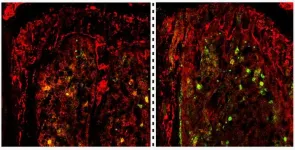(Press-News.org) Most of us who’ve reached middle age have noticed a slowing in memory and cognition, but scientists don’t have a clear picture of the molecular changes that take place in the brain to cause it.
Now, a study in mice has determined that the most pronounced changes occur in the white matter, a type of nervous system tissue that’s integral to transmitting signals across the brain. The study also examined two treatments — caloric restriction and infusions of plasma from young mice — that affect certain regions of the brain, with the plasma appearing to slow the age-related decline.
The results offer insight into the cognitive decline of normal aging, as well as the way aging contributes to neurodegenerative conditions such as Alzheimer’s and Parkinson’s diseases and multiple sclerosis.
In many neurodegenerative diseases, certain areas of the brain are more vulnerable to damage, but scientists don’t know exactly why.
“I saw this study as a way to explain that somewhat mysterious regional vulnerability,” said Tony Wyss-Coray, PhD, a professor of neurology and neurological sciences who led the study that examined gene expression in different regions of the mouse brain as it matures.
Wyss-Coray, the D.H. Chen Professor II at Stanford Medicine and the director of the Phil and Penny Knight Initiative for Brain Resilience at Stanford’s Wu Tsai Neurosciences Institute, is the senior author of a paper describing the research. Oliver Hahn, formerly a postdoctoral fellow in the Wyss-Coray lab and now a principal investigator at Calico Life Sciences, is the lead author on the paper. The paper was published Aug. 16 in Cell.
Different genes found in different regions
The research team sampled 15 regions in both hemispheres of the brains of 59 female and male mice aged 3 to 27 months. They identified and ranked the top genes expressed by cells found in each region of the brain. They identified 82 genes that are frequently found and vary in concentration in 10 or more regions.
The team used these genes to develop a common aging score, assessing how gene activity in different regions of the brain change with age.
The researchers found that the white matter, which is found deep in the brain and contains nerve fibers protected by white-colored myelin, showed the earliest and most pronounced changes in gene expression for mice 12 and 18 months old. According to Wyss-Coray, these mice are about as old, in mouse years, as a person in their 50s.
Tony Wyss-Coray
“We cannot definitively say how gene expression changes in white matter affect memory and cognition. That would require more genetic manipulation and neurobiology work,” Wyss-Coray said. “But we know white matter is the wiring that connects the different brain regions together.”
Past work has shown that aging disrupts an otherwise stable gene expression pattern in the brain, turning on genes that regulate inflammation and the immune response, and turning off genes responsible for protein and collagen synthesis. The inflammation and immune response affect the integrity of the myelin sheath, the insulation layer around nerves responsible for transmitting signals across the brain.
“White matter has been a rather neglected area in aging research, which usually focuses on the neuron-dense regions like the cortex or hippocampus,” Hahn said. “The fact that white matter is emerging in our data as an area of particular vulnerability to aging opens up new and intriguing hypotheses.”
Testing interventions
Interventions to slow the genetic shift that leads to the decline in specific regions of the brain could be beneficial in addressing neurodegenerative disease as well as the general decline associated with aging.
During the study, the team explored two interventions — carloric restriction and injections of plasma from young mice — to evaluate whether they protected against the region-specific shifts in gene expression. Each intervention began when the mice were 19 months old and lasted four weeks.
The researchers found that the dietary intervention caused genes associated with circadian rhythms to turn on, while the plasma intervention turned on genes involved in stem cell differentiation and neuronal maturation that led to selective reversal of age-related gene expression.
“The interventions appeared to act on very different regions in the brain and [induce] strikingly different effects,” Hahn said. “This suggests that there are multiple regions and pathways in the brain that have the potential to improve cognitive performance at old age.”
The team also examined age-related changes in genes associated with three neurodegenerative diseases — Alzheimer’s disease, Parkinson’s disease and multiple sclerosis — that typically affect specific regions of the brain. The expression distribution for each gene had changed in older animals and occurred in regions of the brain that are not typically associated with a particular neurodegenerative condition. This finding could offer insight into the vast number of patients who have neurodegenerative diseases without a firm genetic link.
The study could also offer new opportunities to explore treatments and interventions by using the gene expression data to zero in on the cell populations vulnerable to aging. Future studies could explore how gene expression leads to functional changes in neuronal activity and structure. Wyss-Coray and colleagues at the Knight Initiative for Brain Resilience aim to expand on this work by building similar genetic atlases of aging in the human brain.
“The individual gene changes observed in the mouse may not directly translate to humans,” Wyss-Coray said. “But we believe the vulnerability of white matter to aging probably does.”
Researchers at New York University Langone Health, Saarland University, the Helmholtz-Centre for Infection Research, the Max Planck Institute for Biology of Ageing, Alkahest Inc. and University College London contributed to the study.
This study received funding from the Phil and Penny Knight Initiative for Brain Resilience, the European Research Council, the Max Planck Society, the Schaller-Nikolich Foundation, the Wu Tsai Neurosciences Institute and Foundation Bertarelli, the Simons Foundation, the Cure Alzheimer’s Fund, the National Institute of Aging, the Milky Way Research Foundation, the American Heart Association-Allen Initiative in Brain Health and Cognitive Impairment, and the Michael J. Fox Foundation for Parkinson’s Research.
About Stanford Medicine
Stanford Medicine is an integrated academic health system comprising the Stanford School of Medicine and adult and pediatric health care delivery systems. Together, they harness the full potential of biomedicine through collaborative research, education and clinical care for patients. For more information, please visit med.stanford.edu.
END
Stanford Medicine-led research identifies gene ‘fingerprint’ for brain aging
A study in mice finds that white matter — the tissue that transmits messages around the brain — shows the greatest changes as the animals age.
2023-08-18
ELSE PRESS RELEASES FROM THIS DATE:
Study observes sudden acceleration of flow, generates new boundary layer
2023-08-18
In an experiment on how turbulent boundary layers respond to acceleration in the flow around them, aerospace engineers at the University of Illinois Urbana-Champaign observed an unexpected internal boundary layer.
“Not only were we able to identify a new internal boundary layer, but we were able to systematically track its height so we can understand its growth rate. We also noticed that it only formed if our pressure grading, our acceleration, was sufficiently strong. There was a threshold under which we didn't ...
Being divorced and male among factors that increase risk of lower limb amputation among people with diabetes
2023-08-18
New research to be presented at this year’s Annual Meeting of the European Association for the Study of Diabetes (EASD) in Hamburg, Germany (2-6 October) shows that among people with type 1 and type 2 diabetes, being divorced is associated with a two-thirds higher risk of lower limb amputation (LLA) (amputations below the knee level) compared with being married, and being male is associated with a 57% higher risk of LLA compared with being female. The study is by Dr Stefan Jansson, Örebro University, Örebro, Sweden, and colleagues.
Deterioration in the structure of both large and ...
Researchers find walkable communities are healthier for both mom and baby
2023-08-17
DURHAM, N.H. — Pregnant women that live in walkable communities—with more sidewalks, parks and walking paths—not only engage in more physical activity but are also more likely to experience favorable birth outcomes, according to research from the University of New Hampshire.
The study, published in the journal of Economics and Human Biology, found that expectant mothers living in walkable counties tend to engage in more walking and exercise and have fewer issues with premature births, low birth weight, gestational diabetes and hypertension. Walking is often recommended as a safer, ...
Oregon State researchers develop novel technique for sniffing out toxic algae blooms
2023-08-17
Different cyanobacterial species produce different toxins, said OSU’s Kimberly Halsey, who led the study. Most of them cause gastrointestinal illness and acute skin rashes, and they can be deadly. In 2017, more than 30 cattle died after drinking contaminated water at Junipers Reservoir near Lakeview, Oregon, and blooms particularly pose a threat to dogs entering affected lakes.
Even though the research dealt with just one lake and one toxin, the research demonstrates VOCs’ potential in monitoring critical waterways, said Halsey, associate professor of microbiology in the College of Science.
She said the study published ...
New research: Political attitudes did not change during COVID-19 pandemic
2023-08-17
EAST LANSING, Mich. – There is a traditional understanding that if someone experiences a threatening event, their attitudes and beliefs will change. Some scholars predict that a threat will cause someone to become more conservative on a variety of issues or that they will become more extreme in their attitudes. However, a new study from researchers at Michigan State University and Tilburg University found that Americans’ political attitudes did not change significantly during the onset of the COVID-19 pandemic, contrary to ...
RESEARCH ALERT: City of Hope scientists unravel how TET2 gene deficiency fuels development of acute myeloid leukemia
2023-08-17
FINDINGS
Scientists at City of Hope, one of the largest cancer research and treatment organizations in the United States, have identified how low levels of the TET2 gene fuel the rapid growth of acute myeloid leukemia in animal models. Cell Stem Cell recently published the study.
A team led by Jianjun Chen, Ph.D., the Simms/Mann Family Foundation Chair in Systems Biology at Beckman Research Institute of City of Hope, found that TET2 deficiency sets off a cascade of biochemical changes that enhance the bone marrow cancer’s ability to spread. These changes ...
Sean Jones appointed Argonne’s Deputy Laboratory Director for Science and Technology
2023-08-17
The U.S. Department of Energy’s Argonne National Laboratory has named Sean Jones as deputy laboratory director for science and technology. Jones will begin his new role on October 9, serving as Argonne’s senior science strategist, advisor and chief research officer.
Jones will join Argonne from the National Science Foundation (NSF). In his current role as Assistant Director of the NSF’s Mathematical and Physical Sciences directorate, he oversees a $1.86 billion portfolio that includes five science divisions, domestic and international research facilities, and ...
Carrier receives International Award for Outstanding Leadership
2023-08-17
Julie Carrier, professor and head of the University of Tennessee Department of Biosystems Engineering and Soil Science, was awarded the James R. and Karen A. Gilley Academic Leadership Award during the annual international meeting of the American Society of Agricultural and Biological Engineers (ASABE) in July.
The award was given in recognition of Carrier’s exceptional leadership as department head as well as her ongoing dedication to furthering the UT Institute of Agriculture’s mission to provide research and extension ...
Policies favoring high-volume hospitals may disadvantage rural cancer patients
2023-08-17
PITTSBURGH, Aug. 17, 2023 – Patients with cancer who live in rural Pennsylvania counties appear to know that they may have better outcomes if they receive their cancer surgery at a hospital that performs a high volume of those surgeries, but still opt for lower volume hospitals closer to home when their cancer is likely less complex, according to a new analysis published today in JCO Oncology Practice by health policy scientists at the University of Pittsburgh School of Public Health.
With a shortage of experienced surgeons in rural America and rural ...
Racial and ethnic differences in gut microbiome emerge at 3 months old
2023-08-17
Gut microbiome variation associated with race and ethnicity arises after three months of age and persists through childhood, according to a new study published August 17th in the open access journal PLOS Biology by Elizabeth K. Mallott of Washington University in St. Louis, US, Seth Bordenstein of Pennsylvania State University, US, and colleagues.
Human microbiome variation has been linked to the incidence, prevalence and mortality of many diseases and is known to associate with race and ethnicity in the United States. However, in this context race and ethnicity are considered proxies for inequitable exposure to social and environmental determinants of health due to structural racism. ...
LAST 30 PRESS RELEASES:
Eye for trouble: Automated counting for chromosome issues under the microscope
The vast majority of US rivers lack any protections from human activities, new research finds
Ultrasound-responsive in situ antigen "nanocatchers" open a new paradigm for personalized tumor immunotherapy
Environmental “superbugs” in our rivers and soils: new one health review warns of growing antimicrobial resistance crisis
Triple threat in greenhouse farming: how heavy metals, microplastics, and antibiotic resistance genes unite to challenge sustainable food production
Earthworms turn manure into a powerful tool against antibiotic resistance
AI turns water into an early warning network for hidden biological pollutants
Hidden hotspots on “green” plastics: biodegradable and conventional plastics shape very different antibiotic resistance risks in river microbiomes
Engineered biochar enzyme system clears toxic phenolic acids and restores pepper seed germination in continuous cropping soils
Retail therapy fail? Online shopping linked to stress, says study
How well-meaning allies can increase stress for marginalized people
Commercially viable biomanufacturing: designer yeast turns sugar into lucrative chemical 3-HP
Control valve discovered in gut’s plumbing system
George Mason University leads phase 2 clinical trial for pill to help maintain weight loss after GLP-1s
Hop to it: research from Shedd Aquarium tracks conch movement to set new conservation guidance
Weight loss drugs and bariatric surgery improve the body’s fat ‘balance:’ study
The Age of Fishes began with mass death
TB harnesses part of immune defense system to cause infection
Important new source of oxidation in the atmosphere found
A tug-of-war explains a decades-old question about how bacteria swim
Strengthened immune defense against cancer
Engineering the development of the pancreas
The Journal of Nuclear Medicine ahead-of-print tip sheet: Jan. 9, 2026
Mount Sinai researchers help create largest immune cell atlas of bone marrow in multiple myeloma patients
Why it is so hard to get started on an unpleasant task: Scientists identify a “motivation brake”
Body composition changes after bariatric surgery or treatment with GLP-1 receptor agonists
Targeted regulation of abortion providers laws and pregnancies conceived through fertility treatment
Press registration is now open for the 2026 ACMG Annual Clinical Genetics Meeting
Understanding sex-based differences and the role of bone morphogenetic protein signaling in Alzheimer’s disease
Breakthrough in thin-film electrolytes pushes solid oxide fuel cells forward
[Press-News.org] Stanford Medicine-led research identifies gene ‘fingerprint’ for brain agingA study in mice finds that white matter — the tissue that transmits messages around the brain — shows the greatest changes as the animals age.





